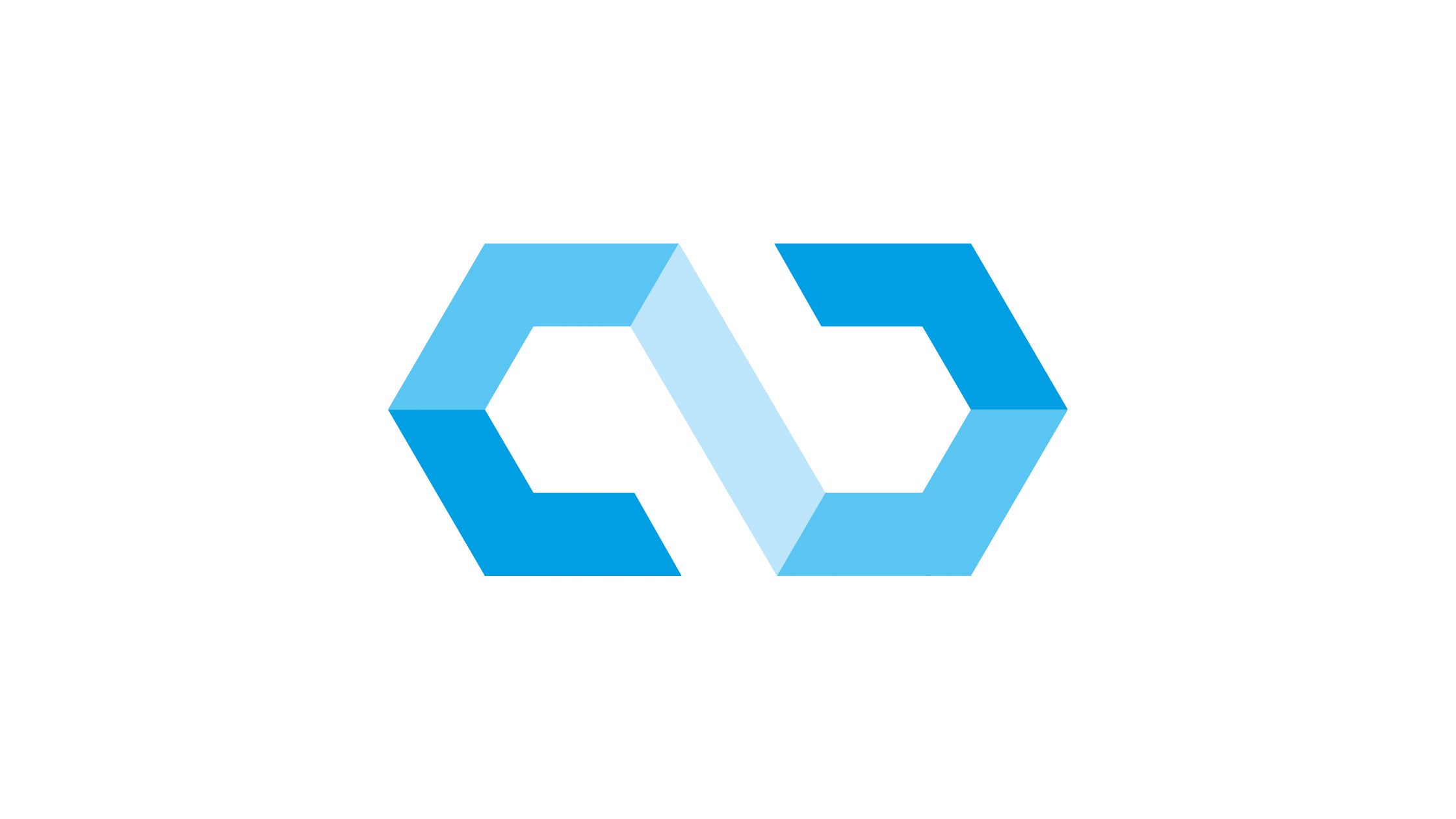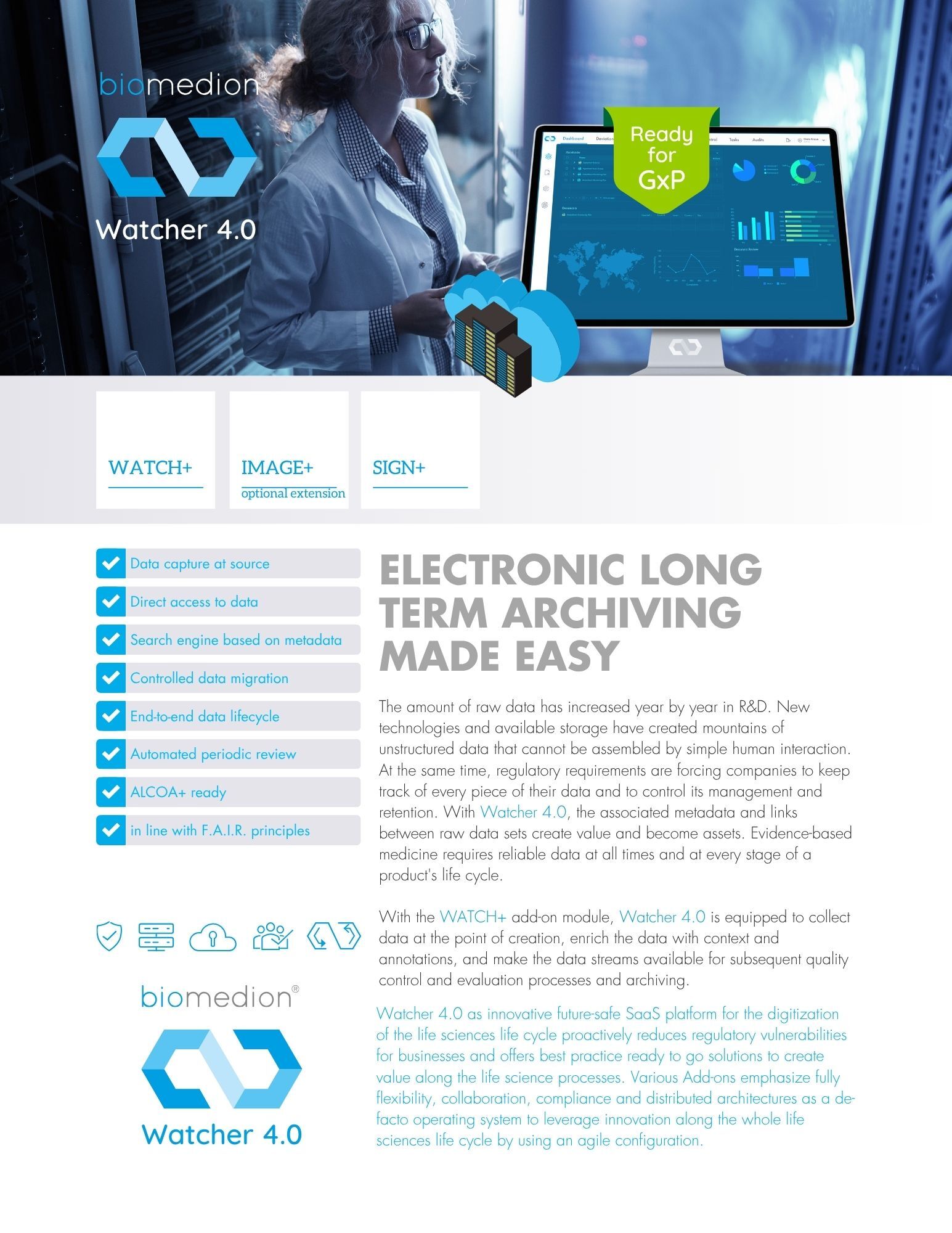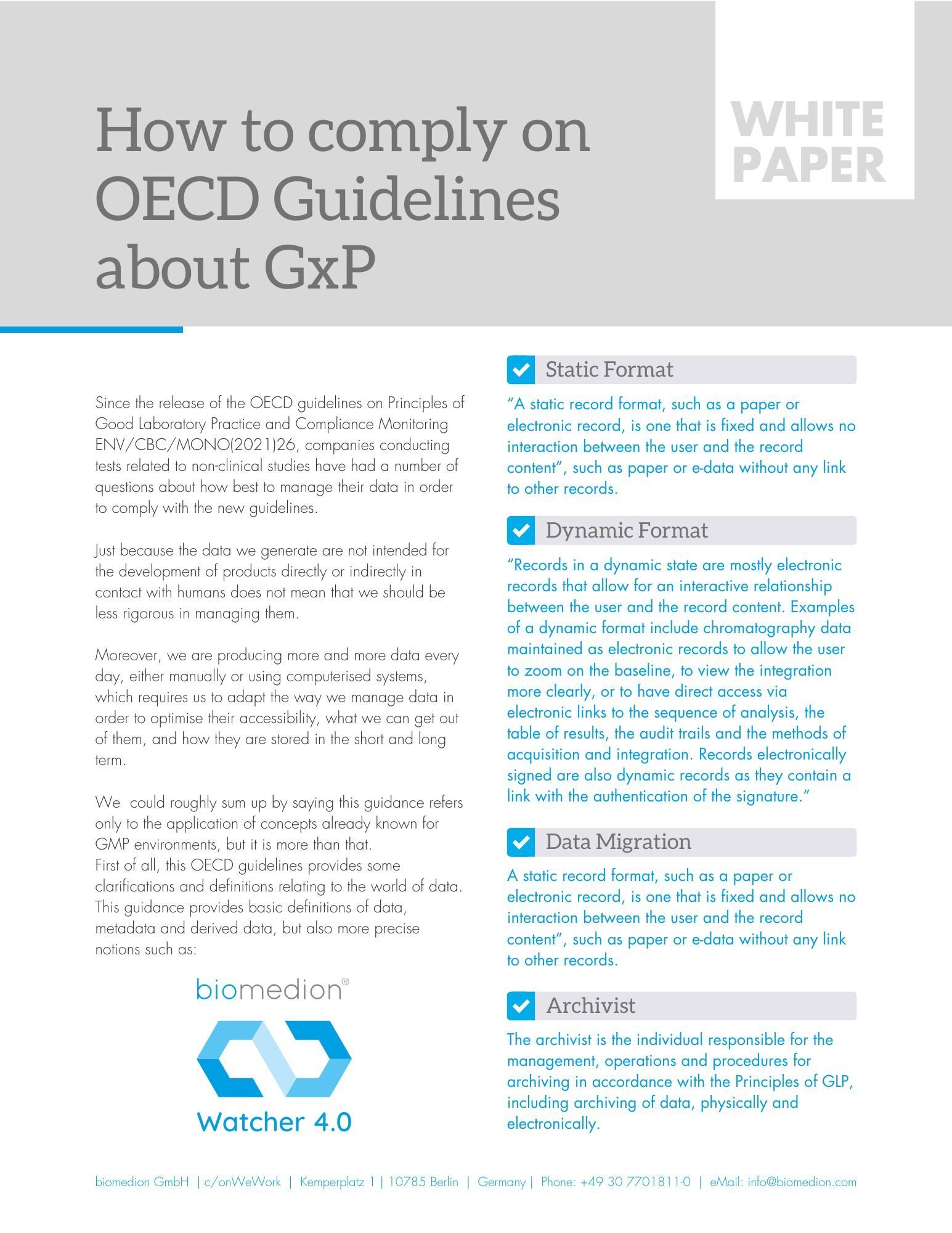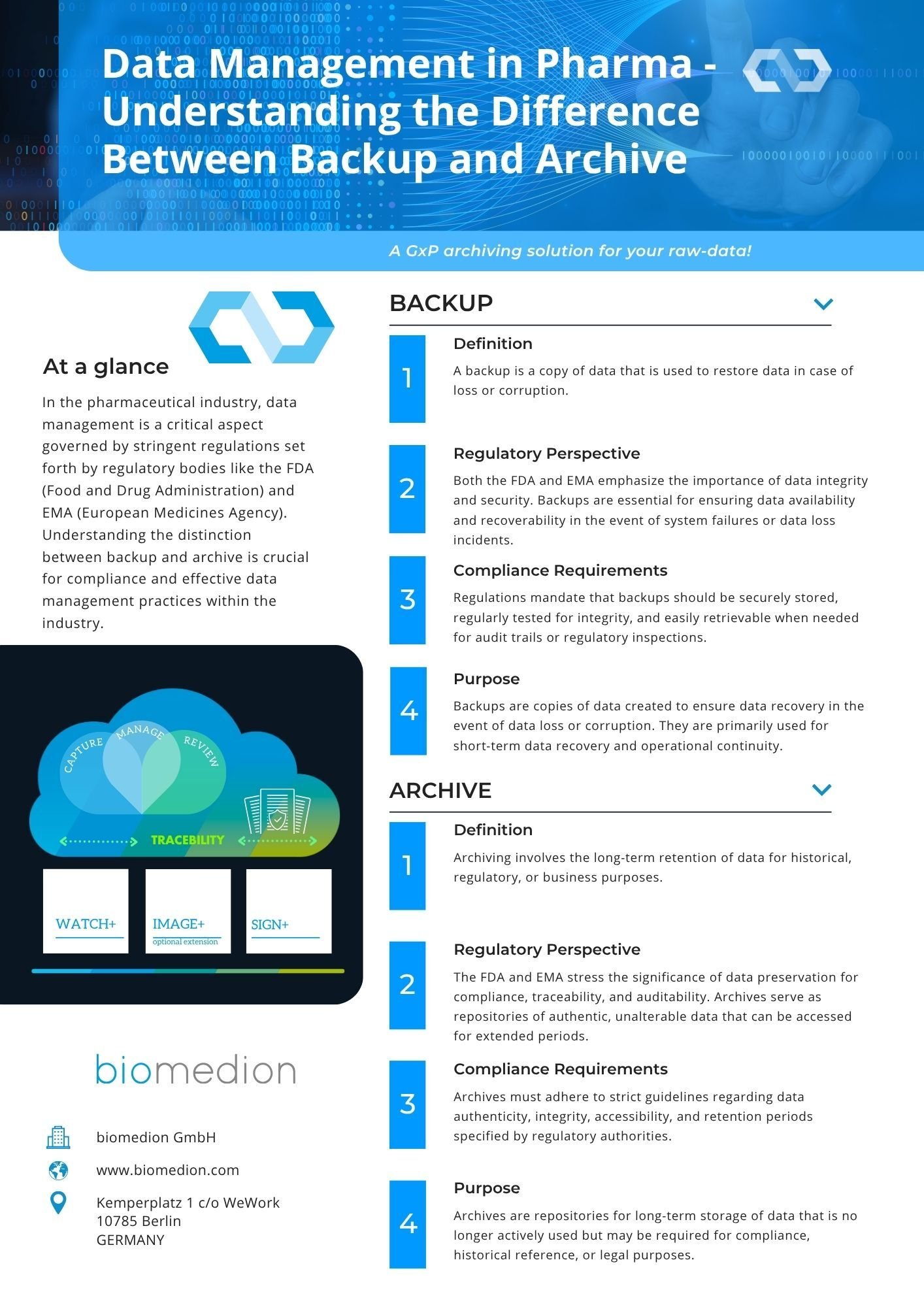The GxP Data Company
biomedion offers a revolutionary long term archiving solution designed specifically for life sciences organizations operating under GMP and GLP regulations. Watcher 4.0 simplifies how you store, manage, and utilize your valuable research data - while ensuring full regulatory compliance - from initial data to the long-term archive.
Seamless, Automated Archiving
Archive data automatically and continuously while ensuring compliance with legal and regulatory requirements, including ALCOA+ guidelines. Watcher 4.0's intelligent agents monitor your laboratory instruments and systems, capturing data at the point of creation without disrupting your workflows.
Searchable and AI-Ready Archive
Leverage metadata-enriched archives for effortless search and retrieval, enabling FAIR-compliant (Findable, Accessible, Interoperable, Reusable) data that's ready for AI training. Transform your archived data into a strategic asset that drives innovation and accelerates discovery.
Reporting and Audit Trails
Streamline workflows, focus your team on core activities, and achieve meaningful reporting with reduced manual effort and robust audit trails. Every action is tracked and documented, ensuring complete traceability and inspection readiness.

Compliance F.A.I.R / ALCOA+
Watcher 4.0 fulfills the F.A.I.R & ALCOA+ principles by design. Our platform ensures data integrity throughout the entire lifecycle, from capture to retirement, meeting the strictest regulatory requirements for FDA, EMA, and OECD-GLP compliance.
Flexible Deployment Options
Watcher 4.0's hybrid archiving functionality for On-Premise and Cloud deployment offers the flexibility to archive data according to your infrastructure needs, significantly reducing the total cost of ownership for long-term archiving while maintaining security and compliance.
AI and Analytics Enablement
By adhering to the F.A.I.R principles, customers can leverage processed data in Watcher 4.0 for training AI models. Unlock greater value from your generated data through predictive analytics, pattern recognition, and data-driven decision making.
User-Centric Design
Easy and scalable configuration of agents to monitor laboratory devices. Reduce efforts to find data through intelligent tagging with relevant metadata. Ensure complete traceability of all data to specific projects, studies, or experiments.
Workflow Management
Starting pre defined Workflows through montoring processes on lab Instruments to e.g. Approve the archiving of Instrument data.
The exponential growth of data generated by analytical instruments, laboratory systems, and electronic documentation requires a solution that ensures traceability, integrity, and regulatory compliance.
Watcher 4.0 delivers exactly that: a powerful platform for reliable long-term archiving of raw data, measurement protocols, and audit trails – fully compliant with GxP, FDA, EMA, and OECD-GLP standards.
The Role of Watcher 4.0 in Modern Laboratories
- Watcher 4.0 identifies, collects, and structures all relevant laboratory data. From spectra and chromatograms to metadata and device configurations – Watcher 4.0 ensures secure, immutable, and searchable storage of critical data.
- Without such an archiving solution, laboratories risk data loss, lack of traceability, or even regulatory findings during inspections by authorities such as the EMA or FDA.
👉 Learn more | Upgrade now
🔁 neuronos is Watcher 4.0 now
introducing a new era of Longterm-Archiving
neuronos is Watcher 4.0: Your trusted GxP-compliant archiving solution, now with enhanced context, scalability, and future-ready architecture.
Get StartedFree consultation
What is biomedion Watcher 4.0, and who is it designed for?
biomedion Watcher 4.0 is a next-generation platform for GxP-compliant long-term scientific data archiving. It is purpose-built for modern laboratory environments that require scalable, secure, and fully contextualized data storage over decades. Watcher 4.0 is particularly suited for greenfield projects, cloud-first strategies, decentralized data capture, and organizations seeking passive-first, validation-light, or hybrid deployment models.
How does Watcher 4.0 capture and contextualize laboratory data?
Watcher 4.0 employs passive data acquisition as its core methodology, continuously monitoring file systems, metadata, and logs without interfering with active systems. This enables non-invasive collection of data from instruments, devices, and software platforms. In addition, Watcher 4.0 offers deep contextualization, recording essential metadata such as data origin, user identity, instrument settings, environmental conditions, modifications, annotations, and digital signatures. This rich context ensures full traceability, meeting stringent compliance and audit requirements for scientific and regulatory reviews.
Which compliance standards does Watcher 4.0 meet, and how does it ensure data integrity?
Watcher 4.0 is fully aligned with global regulatory frameworks, including FDA 21 CFR Part 11, EMA, OECD GLP, and industry best practices. It is designed around the ALCOA+ principles, ensuring that archived data is Attributable, Legible, Contemporaneous, Original, Accurate, Complete, Consistent, Enduring, and Available. Furthermore, biomedion is ISO 9001:2015 certified, reflecting its commitment to quality and regulatory compliance. Watcher 4.0 protects data integrity, patient safety, and product quality across the entire data lifecycle.
What are the key advantages of Watcher 4.0?
Watcher 4.0 offers multiple advantages over previous generations and legacy backup systems:
- Passive, non-invasive archiving that does not interfere with live operations.
- Minimized validation effort (CSV-ready) due to simplified deployment and configuration.
- Modern microservice architecture for scalability, flexibility, and cloud-readiness.
- Self-service UI/UX designed for intuitive user interaction.
- Out-of-the-box audit trail indexing and full versioning for comprehensive data history.
- Advanced SSO integration for centralized access control.
Unlike traditional backup tools focused on disaster recovery, Watcher 4.0 is a regulatory-grade long-term data archiving solution, purpose-built to support regulatory inspections, audits, and lifecycle data governance.
How can existing Watcher 2.x customers transition to Watcher 4.0?
biomedion offers a flexible hybrid migration model tailored to each customer’s needs. Many organizations begin by running Watcher 2.x and Watcher 4.0 in parallel. Watcher 2.x continues managing validated legacy workflows that require deep API integrations and Windream-based document control, while Watcher 4.0 handles new passive data capture streams, cloud integrations, and modern workflows. This staged approach allows organizations to strategically transition toward full adoption of Watcher 4.0 by 2027/2028, ensuring business continuity and regulatory stability throughout the migration.
What are biomedion’s future development plans for Watcher 4.0?
Watcher 4.0 is positioned as the primary innovation platform within biomedion’s product portfolio. Ongoing development focuses on AI-ready features, cloud-native deployment models, and lightweight scaling options to address evolving regulatory, operational, and analytical requirements. While Watcher 2.x remains fully supported beyond 2027, all future innovation efforts—especially those addressing modern data science, real-time analytics, and decentralized environments—are being prioritized within the Watcher 4.0 ecosystem.
What is biomedion Watcher 2.x, and who is it designed for?
biomedion Watcher 2.x is a proven and established platform for GxP-compliant long-term archiving of scientific data. Nicknamed “The Proven Classic,” it is particularly suited for mature, validated laboratory environments that rely on deep system integration, custom APIs, and windream-based workflows. biomedion continues to fully support Watcher 2.x as a stable, compliant solution for customers with specific long-term infrastructure needs.
What core functionalities does Watcher 2.x offer for data acquisition and management?
Watcher 2.x focuses on active data acquisition, offering seamless integration with existing laboratory systems via robust APIs. Fully integrated with windream ECM, including the Transfer Module, the BM-Watcher Agent monitors instrument file systems, detects changes, and automatically creates new versions. It also captures metadata automatically (e.g., from file paths, text files, proprietary formats, or databases), with users able to document reasons for data changes. All files within BM-windream are fully versioned with comprehensive audit trails, ensuring complete traceability throughout the data lifecycle.
How does Watcher 2.x ensure GxP compliance and what role does ALCOA+ play?
Watcher 2.x fully complies with regulatory standards such as FDA 21 CFR Part 11, EMA, and OECD GLP. Both Watcher 2.x and Watcher 4.0 implement ALCOA+ principles, ensuring data is Attributable, Legible, Contemporaneous, Original, Accurate, Complete, Consistent, Enduring, and Available. This ensures data integrity throughout its entire lifecycle. Furthermore, biomedion GmbH is ISO 9001:2015 certified for delivering validated on-premises and cloud-based data archiving services, supporting secure storage and compliant access to raw scientific data.
What are the main benefits of Watcher 2.x as a long-established archiving solution?
Watcher 2.x offers:
- Decades of reliable operation in highly regulated laboratories.
- Seamless integration into existing infrastructures.
- Full control over data acquisition via APIs.
- Complete integration with windream ECM.
- A cost-effective validation pathway as GAMP5-compliant configurable standard software.
- An intuitive Windows Explorer interface, minimizing training needs while maintaining full audit trail functionality.
What limitations or considerations should be kept in mind with Watcher 2.x?
Watcher 2.x requires more validation due to complex systems, supports only active data acquisition, and is mainly for on-premises use. It has limited UI flexibility, versioning, and uses Windows Active Directory for authentication. Its monolithic design includes notification and escalation services. It's best for organizations needing deep, customized integrations with established workflows.
Are there current updates or future development plans for Watcher 2.x?
Yes. The Watcher Q4 2024 release (December 13, 2024) introduced multiple component updates including Watcher Server, Watcher Client, Watcher Hive, Transfer to windream Module, and Email Notification Tool. New features include:
- Workflow Step Flagging for improved recovery after failures.
- windream Server 8.0 compatibility.
- Server Escalation Service (SEC) for enhanced error handling.
- Bulk Update Tool (BUT) to streamline component updates.
- SMB Copy in Archiving for higher data transfer performance.
- Enhanced audit trail indexing for faster search.
- TLS-based notification tool security.
Further updates are scheduled for:
- February 2025 (Patch 1)
- July 2025 (Q2 2025 Release)
- December 2025 (Q4 2025 Release)
trusted by
The GxP Long-term Archiving Solution
Transform Your Life Sciences Data Management with biomedion's Watcher 4.0
Watcher 4.0 is an intelligent data management platform that seamlessly connects your laboratory's on-premise and cloud storage, helping you store, find, and utilize research data more effectively while reducing storage costs.
Key Benefits
Smart Storage Management
Automatically organize and archive your laboratory data across local and cloud storage, cutting costs while maintaining easy access to all your information.
Simplified Data Collection
Set up monitoring agents with just a few clicks to automatically capture data from your lab instruments. Our advanced metadata tagging system makes finding specific data quick and effortless.
AI-Ready Data Organization
Transform your archived data into a valuable resource for AI training and predictive analytics. All data is organized following F.A.I.R. principles (Findable, Accessible, Interoperable, Reusable), making it immediately useful for AI applications.
Automated Workflow Management
Streamline your lab operations with automated workflows that trigger based on instrument activity. From data capture to archiving approval, every step is tracked and documented, ensuring complete research integrity.
Ready to revolutionize your lab's data management? Schedule a demo today to see how Watcher 4.0 can transform your research data into a strategic asset while reducing storage costs.
Download Our Free Publications Today!
Product Leaflet: Introducing Watcher 4.0 - Revolutionizing Data Management in Life Sciences
biomedion is excited to announce the launch of Watcher 4.0, our cutting-edge SaaS platform designed to transform data management across the entire life sciences lifecycle. As the volume of raw data in research and development grows exponentially, Watcher 4.0 offers a sophisticated solution that not only meets but anticipates the needs of modern pharmaceutical development.
White Paper: Updated Guidelines for Compliance with OECD GLP
We are thrilled to announce the release of our latest case study on the best practices and compliance strategies under the updated OECD Guidelines regarding Good Laboratory Practice (GLP). This white paper, rooted in the extensive experience of biomedion GmbH, provides an in-depth exploration of the evolving data management requirements in laboratory settings, crucial for maintaining the highest standards of data integrity and reliability.
White Paper: Data Management in Pharma – Backup vs Archive
In pharma, knowing the difference between a backup and an archive is critical for compliance. This whitepaper explains why backups support recovery, while archives ensure long-term data integrity and regulatory adherence. Learn how to align with FDA/EMA requirements, manage data from instruments like GC-MS and build a compliant, audit-ready data strategy. Discover now how biomedion helps future-proof your data management.
Ready to revolutionize your long term archiving strategy?
Contact our team today for a personalized demonstration of how biomedion can transform your organization's data management.



